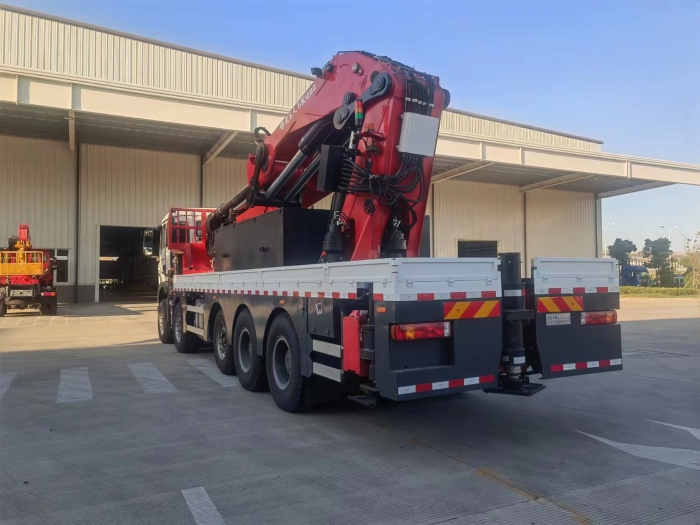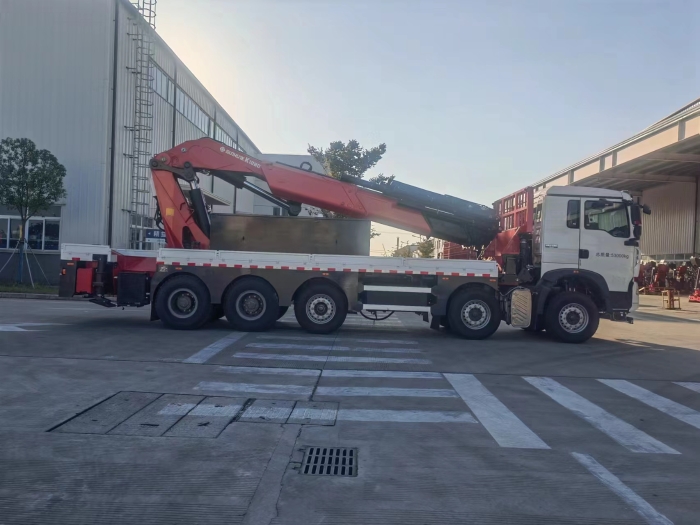- PRODUCTS
- SOLUTION
- SERVICE
- NEWS
- ABOUT US
Choosing a low loader with a crane offers precise, efficient transport for heavy loads up to 100+ tons, reducing loading times and enhancing safety through integrated lifting capabilities.
Low loaders are unique transport vehicles used primarily for carrying oversize and heavy cargo. However, low loaders feature a low deck, thus allowing the use of large cargo that would not have been allowed due to unlimited height or other weight restrictions on standard trailers. In most industries, such as construction, mining, and industrial machinery, in which carrying heavy equipment, such as bulldozers, excavators, and other heavy machinery are used, thus, leading to a high demand for low loaders. A low loader haulage presents numerous advantages that have made it popular in the heavy haulage industry. Although they have other types, the most common type is the nooteboom low loader, for instance, and for others, it is also possible to acquire low loaders for sale, where some companies have been registered with the strategy in low loader haulage in the industry. The concept of low loader haulage offers vast benefits, including versatility, easy loading and unloading, HIAB cranes, and safety.
Versatility of low loader haulage
Most low loaders are versatile and can be used to carry all types of heavy cargo. Low loaders always come in various forms, such as tilting decks for caterpillar loaders, thus carrying a variety of cargo and complex construction equipment. However versatile, low loaders can carry an array of heavy cargo. Examples of the heavy loads include:
· A variety of construction machinery can be hauled, including excavator, bulldozer, and cranes.
· Industrial equipment, including the highest sections of manufacturing equipment.
· Agricultural machinery, including the transportation of tractors and combined droppers.
· Part of the component in infrastructure is hauled.
However, the versatility of the low loaders is contributed to by different configurations and specifically for the extendable decks that are present for long loads and make the low trailers best for heavy cargo.
Benefits of Low Loader Haulage and Details
Versatility of the Service for Various Industries
o Construction: bulldozers, cranes, concrete mixers.
o Mining: draglines, drills, etc.
o Agriculture: tractors, harvesters, irrigation.
o Energy: wind turbine components, transformers.
Characteristics and Advantages
o Load Capacity: from 20 to over 100 tonnes in weight, fulfilling the needs of most heavy transport assignments.
o Ramp and Winch Systems: flip toe hydraulic ramps and trailer-mounted winches available for quicker loading and recovery of the equipment.
o Deck Height: very low when compared to standard trailers so that the height of most loads allows it to be directly loaded. Usually, approximately 0.9 to 1.2 meters high.
Safety of the Haulage
· Crane Equipped: HIAB cranes on low loaders can be used to lift loads if the vehicle is not self-loading, minimizing handling.
· Advanced Braking: Assyst plus and ABS braking systems for the safe transport of heavy loads.
· Certified Safety: All operators are highly trained in safety and operational requirements, ensuring that the vehicle and the team are safe during the loading, delivery, and unloading process.
Specialized low loaders with cranes are the most efficient way to deliver different types of heavy transport because of the vehicle’s versatility, inner safety, and extremely comfortable loading. It is obvious that their specifications and characteristics are irreplaceable in those segments of industry where heavy and oversize equipment is used, and delivery must conform to severe requirements of effectiveness and security.

Certain key factors should be taken into account when selecting a low loader haulage service in order to ensure that your heavy cargo will be successfully, promptly, and safely transferred. These factors should be understood in order for you to make an educated choice and find a haulage service meeting your specific needs.
Fleet Capabilities
o Diverse Fleet: The provider’s fleet should consist of various low loaders of differing sizes and specifications. For instance, some low loaders are provided with extendable decks to allow the transportation of excessively long cargo and some are equipped with cranes to allow the cargo to be self-loaded.
o Load Capacity: The vehicle’s load capacity should be commensurate with the weight of your cargo and not exceeding it. Loads of up to and over 100 tons can be transported with low loaders. Therefore your priority is to choose a provider whose range would correspond to your heavy machinery’s size and weight.
Provider’s Experience
o Industry Knowledge: The provider should have direct relevant industry experience as will better understand your requirements.
o Safety Record: Consider the safety record of the provider because it is a reflection of the provider’s operational practices. Furthermore, its effects can damage your property and pose a threat to the environment.
o Client Feedback: Last but not least, consider the feedback of the previous customers. They are in the same situation as you are and can provide reliable information about the providers.
Modern up-to-date vehicles equipped with the latest technology and safety facilities will decrease the probability of the vehicle breaking down during transport and will minimize the risk of accidental cargo damage during the transportation process.
Maintenance
o Regular maintenance in line with the tightened schedules will reduce the likelihood of mechanical failure.
o Inspection record: Ensure the provider shows you its inspection records to prove that the vehicle complies with all safety and regulatory requirements.
Technological Advancements
o GPS tracking: Modern technological advancements will enable you to keep track of your cargo in real time by means of GPS tracking.
o ABS and ESC: The latest developments in the sphere of low loader manufacture will also equip the vehicle with anti-lock braking system and electronic stability control. As a result, the risk of losing control of the vehicle and having an accident will decrease greatly.
Feature | Importance | Typical Range |
Load Capacity (Tons) | Determines the weight the vehicle can safely carry | 20 - 100+ |
Fleet Diversity | Ensures suitability for various cargo types | Low loaders, crane-equipped, etc. |
Safety Features | Enhances the safety of cargo and transport | GPS tracking, ABS, ESC |
Maintenance Schedule | Reduces risk of breakdowns and ensures reliability | Regular intervals, inspection records |
The right low loader haulage service should be chosen after the provider’s fleet capabilities and provider’s experience have been examined and after ensuring that the fleet is modern and well-maintained. Such a provider will meet your needs exactly and will guarantee the safe and timely transportation of your heavy machinery.

Transportation companies offer a wide range of services that can cater to the most industry-specific needs. Thus, the number one feature is their universality and the comprehensive support at all stages of the work that involves transportation of heavy, oversized, or unusual cargo. Such services can offer support in terms of project management and logistics on both sides, ensuring the smooth transition and delivery of goods.
Heavy Duty Lift Lorry Mounted Cranes
Description of the Service: The vehicle in question is a lorry with a mounted crane that, in combination, can not only transport but also lift the cargo on its own, as well as assemble and disassemble itself. The heavy-duty type lorry provides the most natural advantage of transporting quickly and easily lifted goods. As a result, it is used for loads, such as industrial machinery, parts of oil rigs, or supplies for construction.
Load Capacity: The load capacity can depend significantly and range from 3-ton units to over 100 tons, given the right model and form of a lorry-crane piece.
Boat, Cabin, and Container Transportation
Description of the Service: This type of cargo transportation has high demand, and the provision of such services is one of the core directions of many companies. Special equipment for low loaders or special securing mechanism is used. The containers, boats, or cabins are secured in a way that fits within the loading settings of the vehicle. As a result, they can be safely delivered.
Project Support: Types of projects include analysis of the route hazards and a method statement that specifies how cargo is loaded, secured, transported, and unloaded. The method statement is also called a risk assessment method statement and is a mandatory condition for the provision of transportation services.
Lift Plans
Description – Lift plans are crucial for operations involving crane-lifted cargo. It will detail parameters of the lift, including the weight, crane used, riggings, as well as safety procedures, ensuring that the lift is done as efficiently and safely as possible.
Crane Weight – The required weight capacity of the crane, which will be known beforehand.
Short Duration – Lift plans are straightforward and not time-consuming.
Risk Assessments
Description – Risk assessments will detail potential dangers in the cargo and the process of transporting it.
Route – There will be descriptions of risk associated with the route taken by the cargo.
Method Statements
Description – Method statement will provide detailed instructions for the process of transport, including the loading, transport itself, and unloading stage of the operation.
Loading Method – Loading, usually with a crane, details securing of the cargo.
Service
Comprehensive Service Capabilities – The lift, secured with specialized equipment, allows for the efficient and safe transport of cargo, such as boats and cabins.
Specialized Configurations – Securing methods and equipment will be variable, specializing in the transport of different cargo.
Additional Employment Information – Ensures that all personnel is educated in the process and safety of transportation.
Comprehensive service and project management feature offered by various haulage companies, including risk assessments, method statements, and lift plans, allow for cargo to be transported as efficiently and safely as possible, and in compliance with all regulation. It is a mandatory service for any companies working in the industries that require the transport of heavy, oversized, or specialized cargo, providing excellent logistics in compliance with all health and safety regulations.